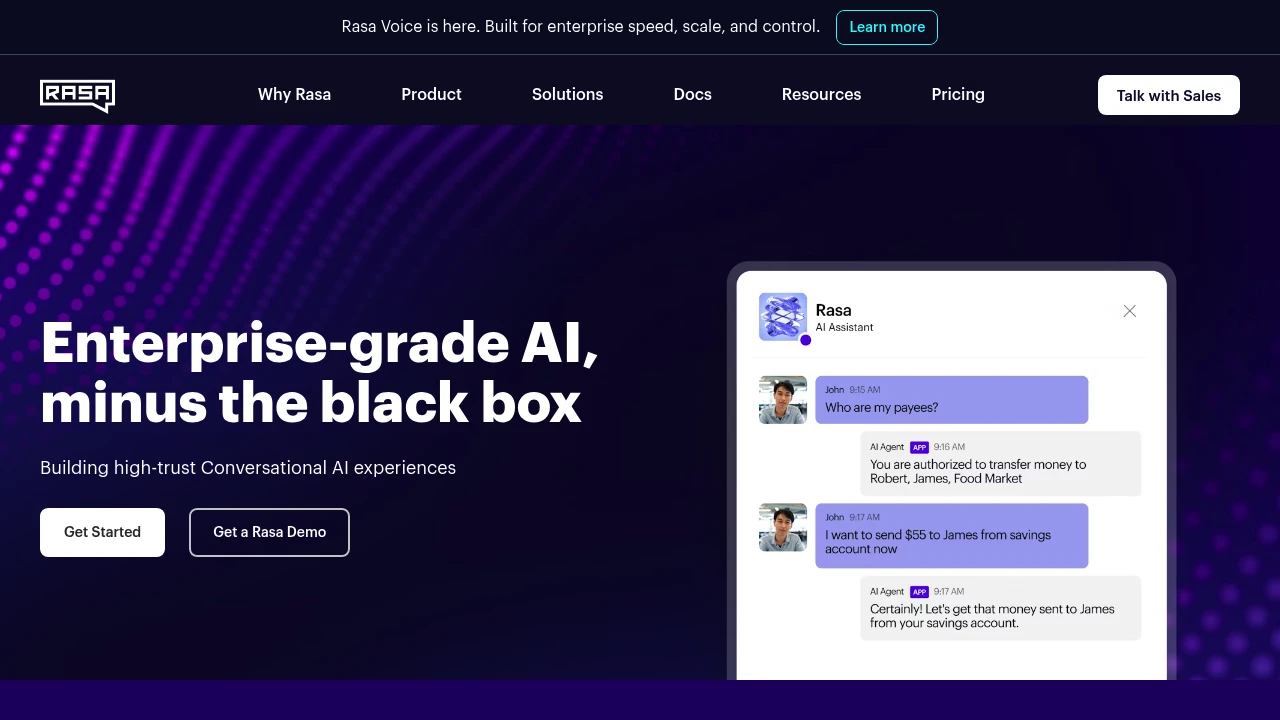Rasa Voice
Rasa Voice lets developers build fully customizable AI voice assistants with strong NLP and dialogue management.

Rasa Features & Overview
Rasa is a conversational AI platform that combines NLU, dialogue management, and tool use in a production-ready stack. You model intents and entities, define dialogue policies, and run custom actions that call your APIs and databases. Teams wire channels like web, WhatsApp, Slack, and telephony, then deploy on Kubernetes or VMs with event brokers and tracker stores. Rasa Pro and Studio add a visual builder, LLM-powered retrieval, analytics, and enterprise controls so assistants scale across brands and regions.
Core Features
- NLU pipelines you control: Build language understanding with configurable components like tokenizers, featurizers, and classifiers. Train DIET-style models, add regex and lookup features, and fine-tune transformers per language for accuracy on domain terms.
- Dialogue policies and stories: Orchestrate conversations with rules and learned policies that predict the next action. Write stories for happy paths, add guardrails for edge cases, and mix forms and slots to gather information reliably.
- Action Server for tool use: Run Python actions that call REST APIs, query databases, and post events. Emit slot updates, schedule follow-ups, and push messages so assistants complete real tasks rather than stop at answers.
- Forms and slot management: Define required fields, validations, and interruptions. The engine tracks filled slots, asks clarifying questions, and adapts when users change answers, which keeps flows resilient under messy input.
- Knowledge and retrieval: Connect FAQ data, docs, or vector search to ground responses. Route between generative answers and templated messages, attach citations in logs for QA, and set freshness policies for frequently changing content.
- Multi-channel connectors: Ship to web chat, WhatsApp via providers, Slack, Telegram, Facebook Messenger, and voice via SIP or CCaaS. Normalize events and metadata so one assistant behaves consistently across channels.
- Testing and quality loops: Run conversation tests, cross-validate NLU, and evaluate confusion matrices. Track regressions in CI, label difficult turns, and promote models only when metrics improve on held-out stories.
- Analytics and observability: Inspect conversation graphs, fallback reasons, and containment rates. Export events to warehouses or dashboards, and trace latency across NLU, actions, and external tools for targeted fixes.
- Security and governance: Keep data on your infra with SSO, RBAC, and audit logs. Mask PII in events, control model allowlists, and separate environments for dev, staging, and production to satisfy internal policies.
- Rasa Studio for teams: Use a browser workspace to design flows, edit prompts and responses, manage datasets, and review conversations. Non-engineers propose changes, while engineers keep code, tests, and CI in sync.
- Deploy anywhere: Package services in Docker, scale on Kubernetes, and choose Postgres for trackers with RabbitMQ or Kafka as the event broker. Blue-green or canary strategies keep upgrades safe during peak traffic.
- Extensibility with code: Add custom components to NLU, write connectors, and integrate policy logic. Treat assistants like software with versioning, typed schemas, and repeatable builds that fit standard DevOps practice.
Supported Platforms / Integrations
- Web chat, WhatsApp, Slack, Telegram, Facebook Messenger, telephony
- Python Action Server and REST webhooks
- PostgreSQL tracker store; event brokers such as RabbitMQ or Kafka
- CI/CD with Docker and Kubernetes deployments
- Analytics exports to warehouses and observability stacks
- Vector search and document stores for retrieval workflows
Use Cases & Applications
- Customer support that resolves tickets and updates accounts
- Sales and marketing assistants that qualify leads and book meetings
- IT and HR helpdesk automations for access, policy, and benefits
- Banking, healthcare, and travel assistants with strict data controls
Pricing
- Open Source: $0
- Pro: contact sales
- Enterprise: contact sales
Why You’d Love It
- Own your data, models, and deployment footprint
- Build assistants that take actions, not just answer questions
- Scale safely with tests, analytics, and enterprise controls
Pros & Cons
Pros
- Strong control of NLU, dialogue, and tool use
- Mature deployment story with Docker and Kubernetes
- Broad channel coverage and deep extensibility
Cons
- Requires engineering time to reach production quality
- Training data and test upkeep add ongoing effort
Conclusion Rasa gives product and platform teams a durable foundation for assistants that actually complete tasks. You design language, state, and actions, wire channels and tools, then measure quality and ship improvements on your own infrastructure. The result is reliable automation that fits your stack and your policies.